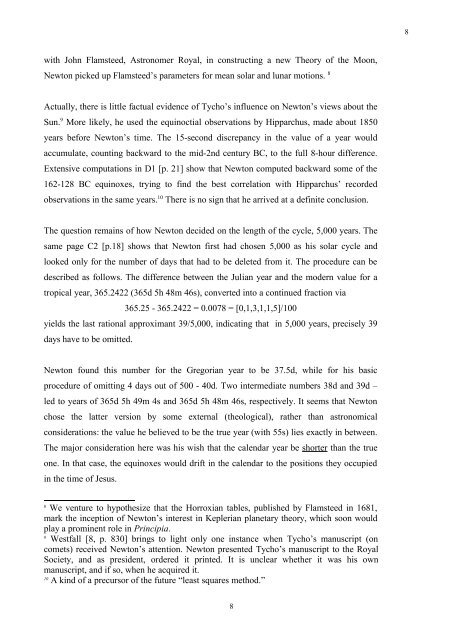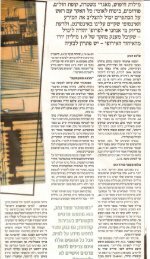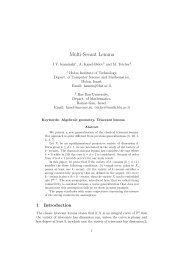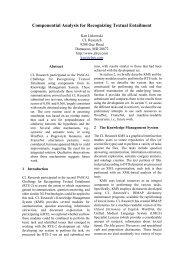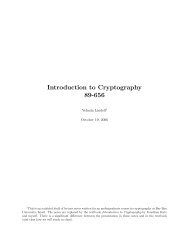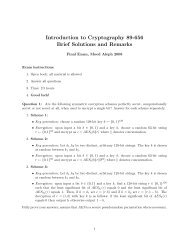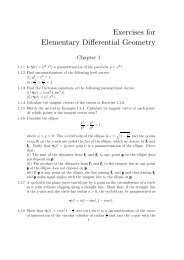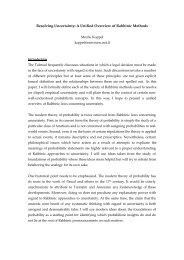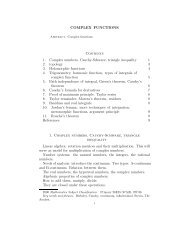Reform of the Julian Calendar as Envisioned by Isaac Newton
Reform of the Julian Calendar as Envisioned by Isaac Newton
Reform of the Julian Calendar as Envisioned by Isaac Newton
You also want an ePaper? Increase the reach of your titles
YUMPU automatically turns print PDFs into web optimized ePapers that Google loves.
8<br />
with John Flamsteed, Astronomer Royal, in constructing a new Theory <strong>of</strong> <strong>the</strong> Moon,<br />
<strong>Newton</strong> picked up Flamsteed’s parameters for mean solar and lunar motions. 8<br />
Actually, <strong>the</strong>re is little factual evidence <strong>of</strong> Tycho’s influence on <strong>Newton</strong>’s views about <strong>the</strong><br />
Sun. 9 More likely, he used <strong>the</strong> equinoctial observations <strong>by</strong> Hipparchus, made about 1850<br />
years before <strong>Newton</strong>’s time. The 15-second discrepancy in <strong>the</strong> value <strong>of</strong> a year would<br />
accumulate, counting backward to <strong>the</strong> mid-2nd century BC, to <strong>the</strong> full 8-hour difference.<br />
Extensive computations in D1 [p. 21] show that <strong>Newton</strong> computed backward some <strong>of</strong> <strong>the</strong><br />
162-128 BC equinoxes, trying to find <strong>the</strong> best correlation with Hipparchus’ recorded<br />
observations in <strong>the</strong> same years. 10 There is no sign that he arrived at a definite conclusion.<br />
The question remains <strong>of</strong> how <strong>Newton</strong> decided on <strong>the</strong> length <strong>of</strong> <strong>the</strong> cycle, 5,000 years. The<br />
same page C2 [p.18] shows that <strong>Newton</strong> first had chosen 5,000 <strong>as</strong> his solar cycle and<br />
looked only for <strong>the</strong> number <strong>of</strong> days that had to be deleted from it. The procedure can be<br />
described <strong>as</strong> follows. The difference between <strong>the</strong> <strong>Julian</strong> year and <strong>the</strong> modern value for a<br />
tropical year, 365.2422 (365d 5h 48m 46s), converted into a continued fraction via<br />
365.25 - 365.2422 = 0.0078 = [0,1,3,1,1,5]/100<br />
yields <strong>the</strong> l<strong>as</strong>t rational approximant 39/5,000, indicating that in 5,000 years, precisely 39<br />
days have to be omitted.<br />
<strong>Newton</strong> found this number for <strong>the</strong> Gregorian year to be 37.5d, while for his b<strong>as</strong>ic<br />
procedure <strong>of</strong> omitting 4 days out <strong>of</strong> 500 - 40d. Two intermediate numbers 38d and 39d –<br />
led to years <strong>of</strong> 365d 5h 49m 4s and 365d 5h 48m 46s, respectively. It seems that <strong>Newton</strong><br />
chose <strong>the</strong> latter version <strong>by</strong> some external (<strong>the</strong>ological), ra<strong>the</strong>r than <strong>as</strong>tronomical<br />
considerations: <strong>the</strong> value he believed to be <strong>the</strong> true year (with 55s) lies exactly in between.<br />
The major consideration here w<strong>as</strong> his wish that <strong>the</strong> calendar year be shorter than <strong>the</strong> true<br />
one. In that c<strong>as</strong>e, <strong>the</strong> equinoxes would drift in <strong>the</strong> calendar to <strong>the</strong> positions <strong>the</strong>y occupied<br />
in <strong>the</strong> time <strong>of</strong> Jesus.<br />
8<br />
We venture to hypo<strong>the</strong>size that <strong>the</strong> Horroxian tables, published <strong>by</strong> Flamsteed in 1681,<br />
mark <strong>the</strong> inception <strong>of</strong> <strong>Newton</strong>’s interest in Keplerian planetary <strong>the</strong>ory, which soon would<br />
play a prominent role in Principia.<br />
9<br />
Westfall [8, p. 830] brings to light only one instance when Tycho’s manuscript (on<br />
comets) received <strong>Newton</strong>’s attention. <strong>Newton</strong> presented Tycho’s manuscript to <strong>the</strong> Royal<br />
Society, and <strong>as</strong> president, ordered it printed. It is unclear whe<strong>the</strong>r it w<strong>as</strong> his own<br />
manuscript, and if so, when he acquired it.<br />
10<br />
A kind <strong>of</strong> a precursor <strong>of</strong> <strong>the</strong> future “le<strong>as</strong>t squares method.”<br />
8


